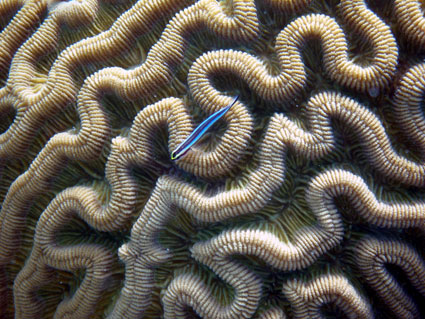Blue Coral
Heliopora (Blue Coral)
Class Anthozoa, Order Helioporacea, Family Helioporidae, Genus Heliopora
Common names: Blue Coral, Blue-Ridge Coral
Natural origin: Indo-Pacific
Sensitivity (Level 2): Usually a fairly tolerant, easy to care for species when fed properly.
Feeding: These corals have very small polyps and need to be fed fine particulate foods. Baby brine shrimp, oyster eggs, and other small particle foods are good. A heavily populated sand bed can also provide some good food for these corals.
Lighting (Level 6 to 10): Heliopora can adapt to a range of light intensities. Ideal lighting will depend on the depth and clarity of the water where the coral was initially collected (or cultured). Usually, more intense lighting is preferred.
Water flow: They will benefit from moderate to strong water flow.
Placement: They are peaceful corals and should be placed away from more aggressive tank mates.
General: Blue-ridge corals are quite unique with their blue, hollow skeletons. Though not a particularly fast growing coral, higher calcium levels (at least 420 ppm) are important.
Sensitivity:
Level 1 – These corals are easy to care for, good for the novice aquarists.
Level 2 – These corals require slightly more attention than level 1 corals, but are generally tolerant and forgiving.
Level 3 – These corals require stable, established aquariums and care by an experienced aquarist.
Level 4 – These corals should only be kept by the most experienced aquarists.
Level 5 – These corals are not known to be able to survive in aquariums even when under the care of the most experienced aquarists.
Note that this scale is not set in stone, but based on the numerous experiences and reports of professional and hobby aquarists. The sensitivity and tolerance of any given coral in your tank will depend on species, health when collected/purchased, how long it’s been in captivity, and other factors that may or may not be knowable.
Lighting Scale (approximations):
Level 0 – no light
…
Level 3 – one foot below modest VHO or T5 fluorescent lighting
…
Level 5 – two feet below extensive VHO or T5 fluorescent lighting
…
Level 6 – one foot below extensive VHO or T5 fluorescent lighting
Level 7 – two feet below 250 watt single ended MH light (or 150-175 watt MH with HQI ballast)
Level 8 – one foot below 250 watt single ended MH light (or 150-175 watt MH with HQI ballast)
…
Level 10 – one foot below 400 watt single ended MH (or 250 watt MH with HQI ballast)
Note that this scale is quite crude and only meant to provide a rough idea of the different levels of light intensities. How much (and what kind of) light actually reaches the corals in your tank also depends on the type of reflector in the light fixture, the temperature of the bulbs/lamps, the clarity of your tank water, etc.
It’s also important to note that different individual corals, even of the same species, can have very different lighting requirements and ideals. Often times, the same types and species of wild caught corals come from different depths and different water clarities. It’s nearly impossible to know what kind or how much light was getting to your coral when it was first taken from the wild. One advantage of aquacultured corals is that you can know what light they were grown under. Beyond health, the color of any given zooxanthellate (photosynthetic) coral will change and adapt in response to the lighting it is placed under. All corals are vulnerable to bleaching if not allowed to acclimate to a change to more intense lighting. If your coral begins to bleach, move it to an area of lower lighting and feed it especially well.
Acclimation:
Please, always take the time to acclimate new corals.
Step 1: Float the bag with the coral in the aquarium water (away from lights!) for about 20 minutes.
Step 2: Open the bag and test the salinity of the bag water.
Step 3: Add about 1/3 to 1/2 cup of tank water to the bag every 10-20 minutes until the bag water and tank water are approximately the same salinity. You can add less water over longer periods of time to acclimate more slowly for more sensitive animals (or when the bag water and tank water have substantially different salinity).
Acclimation can also be done in a bucket (rather than the transport bag). However, the bucket water temperature can get closer to room temperature than tank water temperature (especially for slow acclimations). Insulating the bucket in a Styrofoam box or cooler during acclimation should help.
To acclimate to new lighting conditions, first place the coral in a less light intense area of the tank. Every few days, move the coral towards more direct lighting until it is where you want it to be. If it begins to bleach at any point, move it back to a less light intense area. After the coral recovers, commence moving towards more direct light more slowly.
General “Disclaimer”
These care sheets are a brief presentation of the needs and characteristics of a variety of commonly kept aquarium corals. Though there’s a lot of science in reef keeping, the hobby itself has always been and continues to be an imperfect science. Much is still unknown and there is often more than one way to do things. Please take what’s written here as a starting point, but always keep an active and curious mind.

 Lobophyllia/Symphyllia
Lobophyllia/Symphyllia